
MAY CONTAIN NUTS

Search Shorpy
SHORPY ART

Framed or unframed, desk size to sofa size, printed by us in Arizona and Alabama since 2007. Explore now.
Join and Share
Ad-Free Shorpy
Shorpy is funded by you. Patreon contributors get an ad-free experience.
Learn more.

Recent comments
- +112
- Rear View
- Way in the back --
- Button It Up
- And with an eye on the time ...
- Working in an enclosed ashtray
- Rear View Mirror?
- Tobacco cam
- Basic fact I learned only later in life
- Put a Lid on it!
- Pinstripes in the Tower
- Sound enhancement
- 3438 in '38
- Second Career
- Their days are numbered
- Only the Sensor
- Train control mechanism
- Rarest of the Rare?? & Classy 3400 Class
- Control Mechanism
- Those standpipes
- Wrenches
- International D-40 I believe
- Job prospects
- You had me at Train
- Land of the free
- Broad-Exchange Bldg
- Parking innovation
- The old block
- "Peck turned a sweet propeller"
- National Bank Building
Member Photos
The Shorpy
Printporium
Printporium
Search Shorpy
Search results -- 30 results per page
- Towers of the East: 1940
- ... Rose was also a movie and stage producer, a lyricist, a night club operator (Times Square's "The Diamond Horseshoe") and a speed ... Posted by returntoBuddha - 05/04/2015 - 7:17pm -
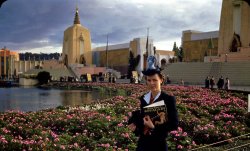
- A Room With a View: 1942
- ... the ships could be seen entering or leaving the harbor. At night, the view with all the lights was magnificent, and the TWELVE nights I ... Posted by Dave - 07/16/2014 - 10:49am -
![A Room With a View: 1942 November 1942. "Babies' Hospital, New York. The welfare of this young patient, suffering from burns, is aided by having his bed placed near a window where he can watch the boats pass by. Nurses learn the importance of ministering the comforts of their patients in promoting recovery." Photo by Fritz Henle for the Office of War Information. View full size.
The Land of CounterpaneThe Land of Counterpane
When I was sick and lay a-bed,
I had two pillows at my head,
And all my toys beside me lay,
To keep me happy all the day.
And sometimes for an hour or so
I watched my leaden soldiers go,
With different uniforms and drills,
Among the bed-clothes, through the hills;
And sometimes sent my ships in fleets
All up and down among the sheets;
Or brought my trees and houses out,
And planted cities all about.
I was the giant great and still
That sits upon the pillow-hill,
And sees before him, dale and plain,
The pleasant land of counterpane.
- Robert Louis Stevenson
Milk sips, Greek shipI wonder what a ship of Occupied Greece was doing in New York.
[It's an American vessel. - Dave]
View To The BridgeI've been trying to figure out where this picture was taken. The view from the window reminds me of a visit I once made to The Hospital for Special Surgery on East 70th Street, however that wasn't built until 1955. It could have been a predecessor or might have been the hospital on the then Welfare (now Roosevelt) Island, which is in the East River between Manhattan and Queens.. I am beginning to believe it was Welfare Island. It is absolutely in The East River. The bridge in the background is the Triborough (now RFK) Bridge. The large building adjacent o the bridge, I believe is a city run psychiatric center on Randall's/Ward's Island near the Hells Gate Bridge. Roosevelt Island is east of East 70th street and its northern extension ends at about 85th Street.
That bridge -seems to me to be the 59th Street/Queensborough Bridge, rather than the Triboro/RFK Bridge. The Triboro is somewhat further north of Roosevelt Island, and unlike the Queensborough does not cross the island. It does, however, cross Ward Island/Randall's Island. The structure of the Queensborough is sort of a gothic truss, while the Triboro is a more graceful Art Deco suspension bridge.
Remembrance of things yet to come ...Reminds me definitively of my extended stay at the US Navy Hospital in Portsmouth, Virginia in December, 1976 for knee surgery. I was a new military dependent, having married a US Air Force Airman the previous July. I had a knee injury requiring surgery, and the hospital at the Air Force Base did not have enough facilities at the time to treat dependents. So I was sent to the Navy Hospital across the river, which being the oldest US Navy Hospital in existence, was/is quite up to the task. Oddly enough, I was treated by an Air Force Surgeon!
I was admitted to the Orthopedic Unit, which happened to be on the topmost floor of the facility, I'm thinking at least 12 stories, in the old building which has since been replaced by brand new facilities recently. I was fortunate enough to get the window side bed, overlooking the river where all the ships could be seen entering or leaving the harbor. At night, the view with all the lights was magnificent, and the TWELVE nights I spent there treated me to some views I will never forget.
(The Gallery, Boats & Bridges, Fritz Henle, Kids, Medicine, NYC)](https://www.shorpy.com/files/images/SHORPY_8b08095u.thumbnail.jpg)
- Jive Bombers Navy Dance Band: 1943
- ... Unit. One of many snaps that I have of this somewhat wild night attended by my Mom & Dad.
Navy dance band Notice how the ... Posted by Paumanok - 07/05/2009 - 3:01am -
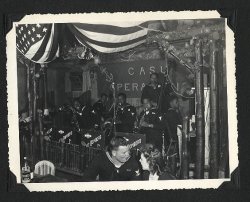
- Waiting for the SP: 1959
- ... the train would have this number displayed (and lit up at night) on the number board so as to distinguish it from other trains in the ... Posted by Rute Boye - 07/27/2012 - 9:38pm -
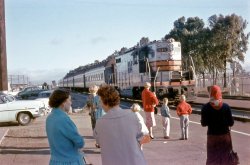
- Jumpers: 1919
- ... hard to do, and rarely seen other than the occasional hunt night at the larger shows these days.
I'll also hazard a guess that the ... Posted by Dave - 08/28/2012 - 3:09pm -
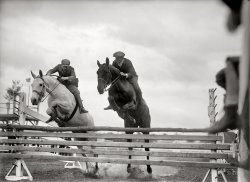
- Hasty Messenger: 1915
- ... May 1915. "Hasty messenger #2. Sacramento, California. See night messenger report." Photograph and caption by Lewis Wickes Hine. View ... What would one have used a messenger service (open all night) for in 1915, anyway?
[I imagine you'd use it for delivering ... Posted by Dave - 04/10/2008 - 10:18am -
![Hasty Messenger: 1915 May 1915. "Hasty messenger #2. Sacramento, California. See night messenger report." Photograph and caption by Lewis Wickes Hine. View full size.
Messenger service?What would one have used a messenger service (open all night) for in 1915, anyway?
[I imagine you'd use it for delivering messages. Which was a big business back when there were large numbers of people both with and without telephones -- if you wanted to get a message to someone across town who didn't have a phone, you'd call Hasty Messenger Service. - Dave]
(The Gallery, Lewis Hine)](https://www.shorpy.com/files/images/03966u_0.thumbnail.jpg)
- Warehouse Fire: 1925
- ... and D streets northwest, shortly after 7 o'clock last night. Merchandise valued at $175,000 was destroyed by the fire, which raced ... Posted by Dave - 09/15/2015 - 6:22pm -
![Warehouse Fire: 1925 A spectacular fire that spread with a rapidity that stunned firemen virtually destroyed the five-story warehouse of S. Kann & Sons, at Eighth and D streets northwest, shortly after 7 o'clock last night. Merchandise valued at $175,000 was destroyed by the fire, which raced through the building as though fanned by a giant bellows.
It is believed that a cigarette was accidentally thrown into a basket of excelsior and that the basket was moved into the packing room from the street. -- Washington Post
January 10, 1925. Washington, D.C. "Fire at S. Kanns warehouse, Eighth and D streets N.W." National Photo Company Collection glass negative. View full size.
ExcelsiorI had to look that up. I guess it's: "Wood wool, commonly known as excelsior, a wood sliver material used for packaging, for the pads in evaporative coolers, and for other applications."
Not quite destroyed
The DramaI happened to be listening to Beethoven's Symphony No. 9 when I opened Shorpy today, I highly recommend it for anyone else viewing this picture.
The dreaded cigarette-excelsior combinationReplaced by such modern contrivances as scented candles and highly flammable pajamas.
[Let's not forget that other combustible classic, oily rags. - Dave]
It Survived, And Flourishes!The building evidently survived as this July 2014 Streetview screenshot seems to show.
(The Gallery, D.C., Fires, Floods etc., Natl Photo)](https://www.shorpy.com/files/images/SHORPY-26584u.thumbnail.jpg)
- Howard the Delivery Boy: 1913
- ... here three months. Goes to the Red Light every day and night. Says that the company could not keep other messenger boys, they work ... Posted by Dave - 08/13/2013 - 3:50pm -
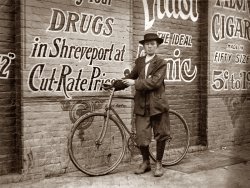
- Santa's Railyard: 1943
- March 1943. Another night shot by Jack Delano, taken on his Santa Fe rail trip west from Chicago in ... Posted by Dave - 08/06/2012 - 11:10pm -
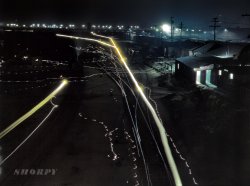
- Missouri Farms: 1938
- ... California.) I re-watched "The Grapes of Wrath" just last night; such an angry movie, much more angry, I think, than the book Steinbeck ... Posted by Dave - 09/08/2011 - 9:39pm -
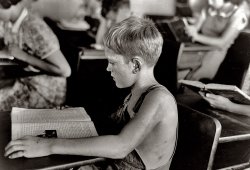
- FAPEX: 1961
- ... globe. I am still using that bedstead, however, every night. 127 Ektachrome slide.
Oh; there was no Second Annual Philatelic ... Posted by tterrace - 06/24/2009 - 5:18pm -
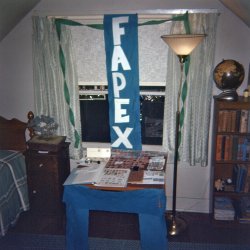
- Bring On the Boomers: 1947
- ... left.
Sloppy work Before the store closed for the night someone didn't do a good job straightening the shelves on the left. Just ... Posted by Dave - 04/11/2015 - 5:54pm -
![Bring On the Boomers: 1947 January 27, 1947. "Kartch's, Main Street, Paterson, New Jersey. Interior from entrance." An early glimpse of postwar retailing in all its amoeboid, trapezoidal glory. Large-format acetate negative by Gottscho-Schleisner. View full size.
Protoplastic, maybe . . . but Amoeboid?So okay, "trapezoidal" may legitimately describe certain design elements here, but nothing I see even remotely resembles that microscopic mass of protoplasm I remember from zoology class.
[Stuff like this. -tterrace]
Okay, if you're referring to that monstrosity hanging on the far wall, which is the only thing resembling any of those Google pics you buried me under. As for your choice of words, you just don't hear "amoeboid" much anymore, which is what really got my attention and which, I suspect, is the very reason you used it! Thanks for the buggy ride!
This basic design held up for 25 years or so. I remember Pomeroy's in Willingboro looking pretty much like this into the early 70's
AtomoidsDon't forget the skewered atoms hanging on the left.
Sloppy workBefore the store closed for the night someone didn't do a good job straightening the shelves on the left. Just beyond are some very well straightened shelves. I've had many retail jobs between my various careers and have never forgotten how to do a proper job straightening shelves. "Don't just stand there waiting for customers, straighten those shelves!"
Space to shopMom always loved stores like this that actually had room for shoppers to move around. Today's stores are so jammed packed, you are either bumping into another shopper, or a shelf, or tripping over stuff that fell on the floor from the last shopper passing through.
(The Gallery, Gottscho-Schleisner, Stores & Markets)](https://www.shorpy.com/files/images/SHORPY-5a17680u.thumbnail.jpg)
- Little Italy: 1902
- ... troupe from Mount Vernon, and closed after the first night.
(The Gallery, NYC) ... Posted by Dave - 12/09/2013 - 9:46am -

- How to Bed a Balloon: 1942
- ... in the sky. It was always an eerie sight, especially at night.
Bombers? Was the U.S. particulary worried about bombers coming ... Posted by Dave - 05/25/2013 - 3:42pm -
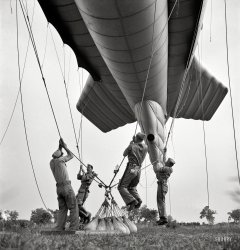
- Sassy Tassels: 1953
- ... closing in April 1954. Ms. McCracken wasn't in the opening night cast but took over the role as principal dancer. Shirley MacLaine was in ... Posted by Dave - 06/26/2020 - 10:34am -
![Sassy Tassels: 1953 New York, 1953. "Actress Joan McCracken [1917-1961] in costume for the musical Me & Juliet." Color transparency by Phillip Harrington for Look magazine. View full size.
Shall we danceJoan was the second wife of legendary terpsichorean genius Bob Fosse.
Short LifeShe’d be 35 here. (Her birthday was New Year’s Eve.) She had her first heart attack two years later, and died in 1961, again heart, with diabetes, at 43. But she was married to Bob Fosse for seven years, and she was known for her lively and vigorous personality. When she found out her brother had died in the Pacific, she trashed her dressing room in sorrow and rage, an episode later used by Truman Capote in "Breakfast at Tiffany’s."
The Majestic TheaterAnd it truly lives up to its name. The view from there near the front doors hasn't changed much. The show played for just over a year, closing in April 1954. Ms. McCracken wasn't in the opening night cast but took over the role as principal dancer. Shirley MacLaine was in the dance ensemble.
ConsonanceSassy tassels. Now that I look it up, I also find sibilance, and half-rhyme or maybe even slant rhyme.
(Kodachromes, LOOK, NYC, Pretty Girls)](https://www.shorpy.com/files/images/SHORPY-03026u.thumbnail.jpg)
- Public Health: 1914
- ... they do with the mountain of debris. Thank you and good night.
[C&D (construction and demolition) debris is one of the top ... Posted by Dave - 08/23/2012 - 5:35pm -
![Public Health: 1914 Washington, D.C., circa 1914. "U.S. Public Health Service and Geodetic Survey Library, B Street and New Jersey Avenue S.E." Where Charles Addams meets Edward Gorey. Harris & Ewing Collection glass negative. View full size.
Now Longworth Bldg.I am surprised by the prominence of the site of this building on Capitol Hill: It would seem that, at that time, public health and scientific exploration were held in greater esteem compared to today. This is now the site of the Longworth House Office Building.
Another location added to my Google Maps mashup of Shorpy D.C. architecture.
View Larger Map
Paging Dr. FrankensteinWhat's on top of the building that looks like an old TV antenna? The box sitting near the lamp post is also a mystery to me.
[It's a wireless mast (radio antenna). The mailboxy thing to the right of the lamppost is labeled "waste paper." - Dave]
Institutional MindsetOne of the commonplaces of design is that architects can seldom do better than their clients demand. The Butler mansion looks as if Butler was raised in an orphanage, or at the least, a grimly expensive private school.
Butler MansionThe following 1931 article accompanied a similar photo. Incredibly, this building was constructed as a pair of private residences in 1889. The granite of the structure is from Cape Ann, Massachusetts, brought to D.C. as ballast in sailing vessels arriving to load coal. The building was purchased by the federal government for $275,000 in 1891.
To the left is the Richards Building, put up in 1871. Its first occupant was the Coast and Geodetic Survey. The government initially leased the property until finally purchasing it for $155,000 in 1891.
Washington Post, Dec 14, 1931
The above picture depicts the old Butler mansion, which once housed the United States Public Health Service, located at 3 B street southeast. It has since been razed.
The establishment was built by the late Maj. Gen. Benjamin Butler, the stormy petrel of the Federal Army during the bitter years of the Civil war. After the close of the conflict he desired a place where he might retire from the turbulent strife of battlefield and public life, and write his colorful, if vitriolic memoirs.
Gen. Butler is best known to posterity as the military governor of New Orleans and for the harsh and tyrannical severity of his regime. In fact so bitter were the proponents of the Confederacy toward his rule that Jefferson Davis ordered him captured and hung as a common felon.
Long before his participation in the Civil War he was leader of the radicals in the Massachusetts Legislature, later being elected to Congress. He also served under Gen. Grant at Richmond and Petersburg.
Later the stately mansion was occupied by Chester A. Arthur, during the first few months of his administration, and after passing through many hands, became the home of the United States Public Health Service.
Washington Post, Feb 17, 1889
Gen. B.F. Butler has not lost faith in Southeast Washington. He has purchased the old Gulick mansion at 222 New Jersey avenue southeast, and is having it remodeled, making two complete houses. The cost of the work will be $10,000. The house No. 222 will be occupied by the niece of the General, and he will himself have an office room on the first floor. This house will contain thirteen rooms and will be heated by steam. The elaborate old marble mantels of the Gulick house are retained in the parlors, while mantels in the other rooms are of tile and antique oak. The hall is eight feet wide and extends back to the dining room, while the stairway leads from the front parlor door line to the second story landing. The newel posts, balusters and stair rails are of ash. The second and third floors are supplied each with bathroom. The first floor is four rooms deep, the second parlor to be occupied by Gen. Butler as an office room. The entire house will be heated by steam. the house No. 222½ will contain twelve rooms and will finished in a similar manner to the one just described. This house, it is understood, will be rented when ready for occupancy.
MaterialWhat do they DO with all the 'stuff' when they tear down a building this size?? I mean, look at that thing! HUGE stone blocks, giant slabs of concrete...where does it all go? It can't just go into the landfill, can it? When I see the modern Google version of these Shorpy sites I first wonder a) what in the hell were they thinking, and b) what did they do with the mountain of debris. Thank you and good night.
[C&D (construction and demolition) debris is one of the top landfill components. As for the "modern version" of what's there, I think the current building looks a lot nicer. - Dave]
No Place Like HomeI'm usually a fanatic for historic preservation, but even I have to say that the Butler Mansion is the least homey home I've ever seen. It has "administrative building" chisled all over it.
(The Gallery, D.C., Harris + Ewing, Medicine)](https://www.shorpy.com/files/images/13557a.thumbnail.jpg)
- Water Boys: 1926
- ... Swimmers I think they would get arrested and spend the night in jail for this now. In the Reflecting Pool!? Too bad.
"The ... Posted by Dave - 07/17/2012 - 10:13pm -
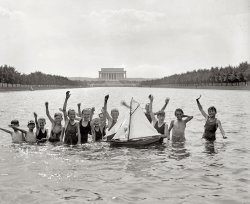
- Rabbit Maranville: 1913
- ... manager, he woke up his players on the train late at night proclaiming that there would be no sleeping on this road trip under ... Posted by Dave - 09/07/2011 - 8:03pm -
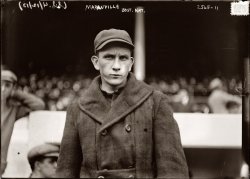
- Hip, Hip Ouray: 1939
- ... bet that I rented a room in the house at lower left for a night while hitchhiking through. That was the 70s! Nothing available to rent in ... Posted by Dave - 01/11/2018 - 5:27pm -
![Hip, Hip Ouray: 1939 October 1939. "Ouray, Colorado, center of a gold mining region and developing tourist center." Nowadays a sort of alt-Aspen without the skiing. Photo by Arthur Rothstein for the Farm Security Administration. View full size.
Room for Rent?I would ALMOST be willing to bet that I rented a room in the house at lower left for a night while hitchhiking through. That was the 70s! Nothing available to rent in town, but I got the skinny on private people who rented. Nice lady allowed me to stay for a ridiculously low price.
IceboxOne of my favorite towns on the continent! The little box canyon occupied by the town of Ouray is aligned north and south, thereby affording very few hours of direct sunlight - especially in winter. That fact, combined with the little burg's 7,800 ft altitude, makes Ouray a really frosty place!
Ice climbing competitions are held annually (January 18-21, 2018 http://ourayicepark.com/ouray-ice-festival/). After an icy afternoon watching climbers scale frozen, piped-in waterfalls, celebrants can warm up in one of the county's several hot springs. The city just refurbished the municipal pool/hot spring and several hotels have private soakers.
One establishment has a thermal spring in a grotto/cave blasted out of the rock foundation. The sulphur-scented trickle heats the "Vapor Cave" up to about 108 degrees.
That'll thaw your frosty bits.
Goober Pea
Just been curious!Dave, I've been wondering, do you get ANY sleep of substance? Why, I ask! Because I see you staying up nights thinking of all the quirky, clever, "right-on" titles you're always using!
Kudos! Wish I could think of a clever, quippy something to say here, but I am at a loss!
[Kudos and coffee are what keep us going! - Dave]
For Great SkiingOnly about 10 miles as the crow flies here to Telluride. But from my time living on the Western Slope? Trust me, in the winter it can be a two hour drive. Incidentally, in the photo the slight jog of the road down on the bottom to the left starts the heavily switchbacked trek up the Million Dollar Highway, one of the true engineering marvels of the West, and still in the right conditions one wild, white knuckle ride and without many guardrails.
LocationUsing Google Maps and the shape of the mountains as a guide, my best guess is that this was taken from the Million Dollar highway or the hills to the south, looking north up Main Street. This is the best view I could get:
https://tinyurl.com/yaumgcb2
(The Gallery, Arthur Rothstein, Landscapes, Small Towns)](https://www.shorpy.com/files/images/SHORPY-8b18771a.thumbnail.jpg)
- Guard Camp: 1912
- ... photos (some of the Guard) can be found here . Last night: Hayden, Verdi and Schumann with the Wister Quartet to a katydid ... Posted by Dave - 08/01/2008 - 11:18pm -
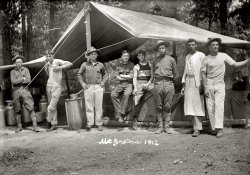
- Nathan, Sleepy and Weldon: 1942
- ... photos of the Drake family entertaining at a Saturday night dance for the Farm Security Administration's resettlement camp at ... Posted by Dave - 08/10/2012 - 4:56pm -
![Nathan, Sleepy and Weldon: 1942 From February 1942, another of Arthur Rothstein's photos of the Drake family entertaining at a Saturday night dance for the Farm Security Administration's resettlement camp at Weslaco, Texas, home to many farm families displaced by the droughts and bankruptcies of the Dust Bowl years. The fiddle player is Nathan Drake; on banjo and guitar are his sons Jasper ("Sleepy") and Weldon. Thanks to Jasper's daughters Connie and Janette for providing the names. View full size. (I'm having a Shorpy family moment here, having heard from the photographer's daughter, Annie Rothstein-Segan, and now Jasper's daughters. Life is a circle.)
Drake familyThis photo is in the book "Picturing Texas." It's the only one we thought existed. I am sure Annie is having a blast seeing all the pictures her Dad took! Thanks to him we all have just a few more memories!
[Yes, we owe Arthur Rothstein a lot for all that hard work. There are a few more Drake photos in the Library of Congress archives. I'll post as many as I can find. Click here for the gallery. - Dave]
Tenor BanjoIt is interesting that the banjo is the older style 4 string tenor banjo, not the more modern 5 string banjo. You don't see those very often these days. Compared to the 5 string banjo it's tuned differently and the style of playing is different. Usually it is strummed rather than fingerpicked.
Banjo HistoryThe four-string (tenor or plectrum) banjo is actually later than the five-string.
(The Gallery, Arthur Rothstein, Drake Family, Music, Rural America)](https://www.shorpy.com/files/images/8b16678u.thumbnail.jpg)
- Amelia Earhart: 1932
- ... received a supreme award for courage and achievement last night when President Hoover presented her with the first gold medal of the ... Posted by Dave - 06/09/2014 - 1:15pm -
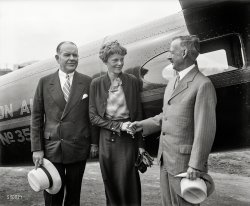
- Ice Baby: 1941
- ... "back in the day".
After spending several hours last night looking for some evidence myself of your bald assertion, ... Posted by Dave - 12/27/2018 - 12:00pm -
![Ice Baby: 1941 January 1941. "Workers' houses near Pittsburgh Crucible Steel Company in Midland, Pennsylvania." Acetate negative by Jack Delano. View full size.
BrrrrrrrrrHaving grown up in Philadelphia, I can say the smart people are INSIDE!
Red is grey and yellow whiteBut we decide which is right
And which is an Illusion.
So, the traffic signal is on red or green?
The Non-Romantic Look of Cold and SnowGrey, cold, bleak. Delano is awfully good at bringing out that look. (And this is a great picture, right down to Mother and child at the window).
Wikipedia notes that, after the War, Delano settled in Puerto Rico. The antithesis of the cold, snow, bleak we see in these pictures. Hmm.
Stamped sheetmetal sled runners and uprightsCommon until well into the '60s, the runner sliding surfaces were just one edge of an L, often not well-made enough to be actually straight upright. And they were bendy. Not very good unless everything was frozen completely solid. The L flange needed to be much wider for snow. Kind of useless actually.
As kids we were so envious of the kids from next door. They had two sturdy sleds built by their father - the sliding surface runner was inch-wide metal strap firmly screwed to solid wood uprights - no bending. They made our store-bought sleds seem second rate and slid far further.
Re traffic lights: everywhere in the world, red is the top light!
[Incorrect. Back in the day, green was the top light on many a stoplight. - Dave]
Incorrect? Hardly, from my and any reasonable point-of-view.
Saw your other post after I sent mine, so I'll just ask you - back in what day, exactly? You need to provide some real evidence, like a street photo, of these rarely-occurring anomalies. tterrace's example is of a one-off design that never made it commercially. Hardly proof of widespread green light on top traffic signals even "back in the day".
After spending several hours last night looking for some evidence myself of your bald assertion, following my reading of an earlier Shorpy post which I actually read after the one I responded to, I was unable to find anything that sways me to it. Not a thing.
There is of course the Wikipedia entry about the Irish green light in Syracuse NY, and the debacle over that one light was in the 1920s! That had to be done as a special case because it did not meet the New York State Dept of Transportation guidelines in 1925. Maybe there's an anorak website with every combination of everything that ever happened in traffic light design somewhere - I couldn't find it. It would hardly matter if I had in the greater scheme of things.
So it seems no more than somewhat likely that green light on top might have been used by a mere few municipalities in the US, and probably before 1920. Nobody else worldwide bothered to get it wrong! Due to local financial concerns, sure, some anomalies may have not been replaced for years, confusing the color-blind and those folk who never can quite remember their left from right or east from west. Those who "remember" green on top are in that category, I'd suggest. Having conducted many safety hearings following accidents in my career, one thing I do know is that most people are quite unobservant, because their recounting of incidents never matches exactly, and some are fantasy.
There is all sorts of history as to why red is placed on top, both for longer visibility in fog due to color sensitivity and earlier detection by the motorist cresting a hill before an intersection, and so on. Not to mention catering to the 20% of males with red/green color-blindness by standardization of position.
A traffic light in Philadelphia in 1941, though? Get away with you. I'd bet money it was standard configuration.
An extremely minor use of green on top may have occurred, sometime, somewhere, a hundred years ago. I'll agree to that. But as a useful reaction to my and others' comments, to call universal use of red on top "incorrect" is pedantry. I know it when I read it, because I tend to be a pedant myself. Comes from being a professional engineer for 42 years and a manager of them for half that. So who cares about the .01% of lights that might have been upside down long ago? Not even me.
You own the site - you can claim right by might. However, if you insist on calling me incorrect, using the reason that very occasional anomalies once existed, remove my entire post forthwith, please. There are civil ways of mentioning occasional occurrences of something as points of interest. To make a bald impolite assertion of "incorrect" I cannot accept and won't be associated with in this case, thanks all the same.
[Green-on-top stoplights were (literal) fixtures of my childhood. On cross-country family trips in 1965 and 1971, I'd announce them to the rest of the car whenever I saw one, mostly in small towns of the American West. It took less than a minute of googling to find the ads below -- from the 1930 trade publication "Municipal Index," both showing green-on-top signals. Which I suspect comprised a substantial percentage of early 12-lamp fixtures. - Dave]
Click to enlarge.
On every cornerThe mom and baby are likely watching the kid on the sled, who's eyeballing the photographer right back. Fun family scene. Then there's that guy who's on every corner in these shots, the needs-a-drink guy. My seasonal best wishes go out to him this year.
In Defense of the Flexible FlyerThe sled which looks like to me as my old friend, Flexible Flyer, and panned as kind of useless actually by conundrum was not useless but loads of fun for my family.
Bought originally around 1940 for my older sister and used into the late 50's by my younger brother was a platform for daring do down the hills of Clifton Park.
Through the years there were many combinations of family and friends who rode the sled downhill towards Belair Road off a green adjacent to Clifton Park Terrace. The best snows were on weekends when Dad would be off and he would come along.
My father had taught my sister then my sister taught me and I in turn taught my brother.
When we were nearing the freezing point Dad took us to a store at Mareco and Belair that sold hot chocolate where he would order up us kids a round while he took Mom a few doors up to a local tavern for a shot of rye and a Gunther beer for himself and for Mom an Arrow draft beer.
Someday I'll have to get into the discussions my parents and my aunts and uncles on my father's side had about Gunther and Arrow beer when they came to our house for a Sunday afternoon visit.
Aunt Ana was neat since after drinking a beer she could blow up a balloon and it floated to the ceiling. Uncle Donald was cool too since he always had a few risque jokes to tell so he would give the kids a dime each to go buy some candy at the confectionary store up the street. At the time that bought a lot of candy since they were all penny candies and some were even 2 for a penny.
(The Gallery, Factories, Jack Delano, Kids)](https://www.shorpy.com/files/images/SHORPY-8c04464a.thumbnail.jpg)
- Washstand Cowboy: 1939
- ... house or vardo or yurt or log cabin, to rent at $400 per night to tourists from LA and San Francisco, flying in for a week to "slow ... Posted by Dave - 01/23/2018 - 3:18pm -
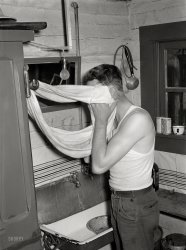
- Safe at Home: 1942
- ... rallies. Jeep headlights form V for Victory at the night rally for Pennsylvania anthracite miners in Wilkes-Barre on Sept. 29. ... Posted by Dave - 11/05/2013 - 11:24am -
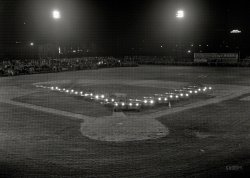
- $900 Million: 1914
- ... a hole in the wall so you could put your money in at night.
(The Gallery, D.C., Natl Photo) ... Posted by Dave - 01/06/2012 - 7:10am -
![$900 Million: 1914 1914. "Treasury Department, Office of Comptroller of Currency -- bond vault. Contains bonds to the value of $900 million securing government deposits and postal savings fund." National Photo Co. glass negative. View full size.
Smoke BreakLooks like he's reaching for the fan switch before they light up.
Then and Now$900 mil would be +/- $20,360,700,000 in 2011 according to the inflation calculators.
US Postal Savings, existed from January 1, 1911 until July 1, 1967. It was still big in Europe the last time I looked. This system was set up by the US Government to act as a saving account for anyone too poor to have a saving account or lived too far from a bank.
Two weeks worth of warThe direct cost of U.S. involvement in WWI was roughly $23 billion, from the U.S. declaration of war in April 1917 until the end of the war in June 1918. (Source: "Direct and Indirect Costs of the Great World War" 2d ed. [Washington 1920] by Ernest L. Bogart.) So the $900 million represented here covered the cost of two weeks of the looming "war to end all wars."
Glass ceilingWhat's going on with the top of the glass plate? At the top, it appears there's part of another picture, and the I-beams and everything else are abruptly cut off.
[It's the very top portion of another shot taken at the Treasury Department at the same time. At some point in the past, prints were copied to glass negatives and these two happened to be stacked unevenly atop one another.]
Postal SavingsFrom what I've been told about my coal miner grandfather, he used the postal savings exclusively. He distrusted banks, saying that (back then) there were any number of counters for making deposits, but only one for withdrawals. According to him, they even knocked a hole in the wall so you could put your money in at night.
(The Gallery, D.C., Natl Photo)](https://www.shorpy.com/files/images/31485u.thumbnail.jpg)
- Swing Your Partner: 1940
- December 1940. "At a Saturday night square dance in Clayville, Rhode Island." Medium format acetate negative ... Posted by Dave - 11/13/2018 - 12:15pm -
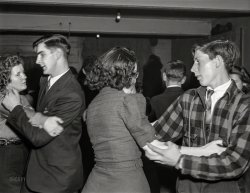
- Chicken Inn: 1937
- ... Rooms en suite with bath. Electric lights day and night. Fresh vegetables from our own gardens. Garage."
Sounds nice.
Car ... Posted by Dave - 02/22/2017 - 2:58pm -
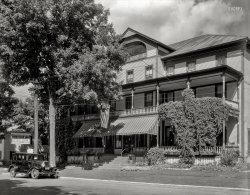
- Coat Check: 1909
- ... Times article carefully, you would: petition to spend the night, wash up vigorously, then leave your clothing in the basement while you ... Posted by Dave - 09/09/2011 - 2:20pm -
![Coat Check: 1909 New York municipal lodging house circa 1909. "Fumigating clothing." From the New York Times: "There is a basement and subbasement, the latter containing the boiler and batteries for lighting and heating. The basement contains the shower baths for men and the steam and formaldehyde cleansers, the laundry, and the vacuum sweeping apparatus. ... All applicants for accommodations will be forced to undress before going to their rooms, which they will enter after they have taken a bath and their clothes have been thoroughly fumigated. The arrangements for the latter are most novel. The clothes are placed in small crates or boxes, which are then wheeled into large steam and formaldehyde retorts. When they are finally taken from their place before the men and women to which they belong are ready to leave the house in the morning, they are entirely cleaned." 8x10 glass negative, George Grantham Bain Collection. View full size.
Scary scenarioI don't think you could present anyone with a plan like that today.
Lodging HouseSo, reading the NY Times article carefully, you would: petition to spend the night, wash up vigorously, then leave your clothing in the basement while you join the other exclusive guests. In the morning, men and women exit the boarding house looking crisp and dapper. Sounds like a pretty wild place...
Seriously, what DID they wear?
[A nice Department of Public Charities nightshirt. - Dave]
LiceAmazing setup. I think the fumigation was to kill the lice in their clothes. Typhus was a serious problem back then, as well as other louse borne diseases.
(The Gallery, G.G. Bain, NYC)](https://www.shorpy.com/files/images/01799u_0.thumbnail.jpg)
- Ectoplasmic Express: 1908
- ... Niagara Falls, New York, circa 1908. "Falls Street at Night." A scene last glimpsed here . Note the ghost streetcar stopped ... Posted by Dave - 01/20/2017 - 10:09am -
![Ectoplasmic Express: 1908 Niagara Falls, New York, circa 1908. "Falls Street at Night." A scene last glimpsed here. Note the ghost streetcar stopped mid-frame in this time exposure. 8x10 inch dry plate glass negative, Detroit Publishing Company. View full size.
Talking Pictures in 1908?Thomas Edison experimented with synchronizing a crank wound phonograph with his early moving picture film around the turn of the century...
[The poster to the right of the entrance announces the theater is using E.E. Norton's Cameraphone system. -tterrace]
This has me intriguedI've never heard of "Talking Pictures" this early. I wonder what they were.
[Explained in a comment to the earlier photo linked in the caption. -tterrace]
Ghost bicyclistWhat a great photo! I can spy a couple of ghosts on the sidewalk on the right, and it would also appear from the streak of light that the bicycle that's parked by the curb on the left arrived while the lens was open.
Barrel HoodA lovely "barrel hood" Franklin, parked at the curb
(The Gallery, DPC, Movies, Streetcars)](https://www.shorpy.com/files/images/SHORPY-4a23128a.thumbnail.jpg)























